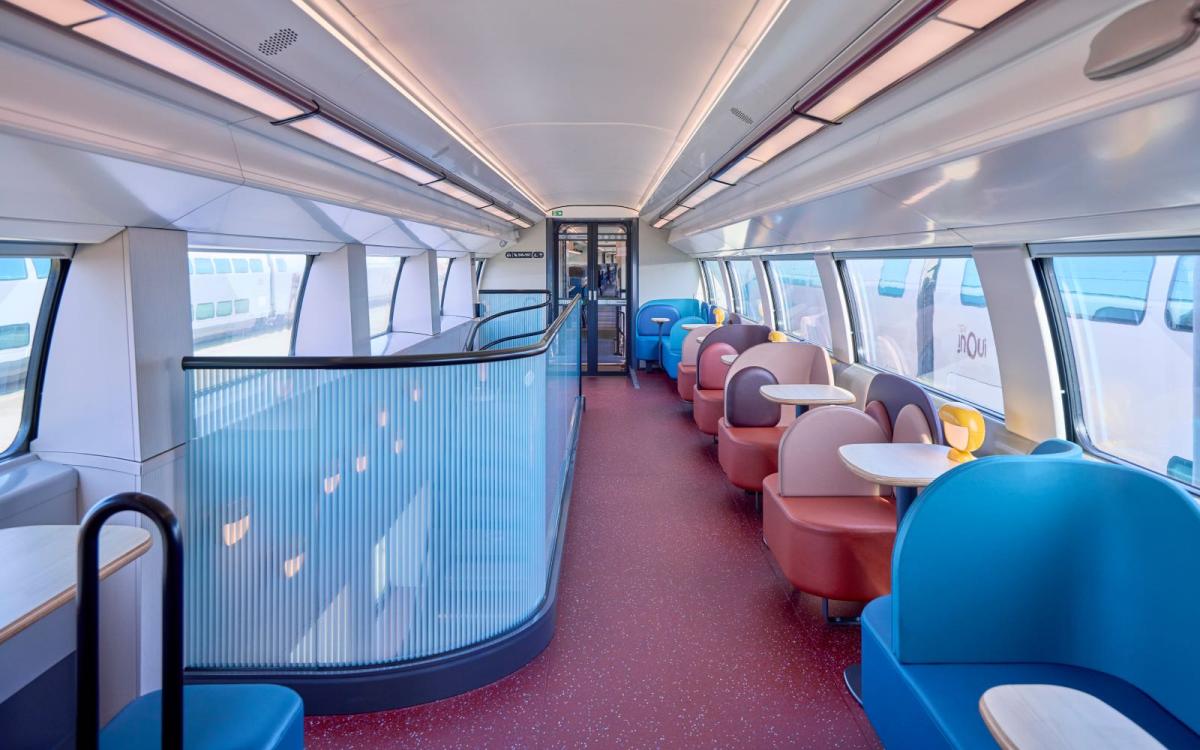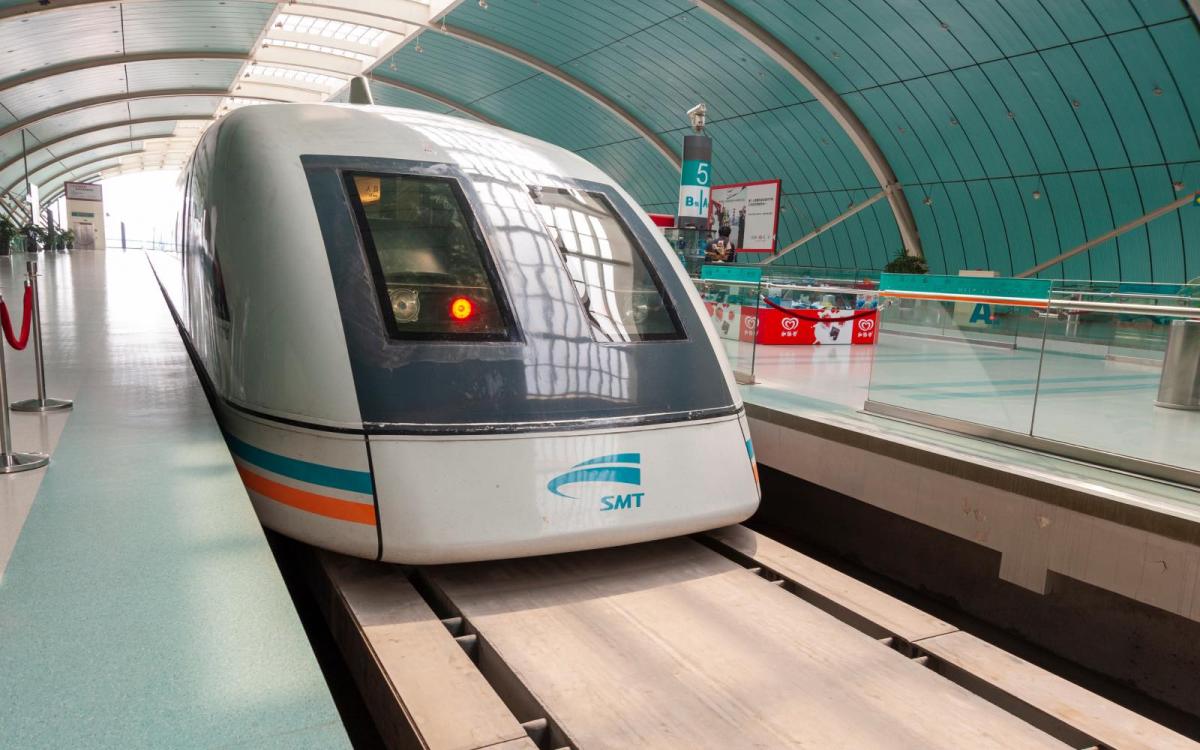
The spotlight
Last month, France’s national railway operator released a glimpse of the designs for its upcoming fifth-generation high-speed train, the TGV Inoui. (TGV stands for train à grande vitesse, or “train of great speed.”) The glossy, well-lit photos show brightly colored interiors, cushiony seats, and sleek tables with rounded edges — even an eye-catching new table lamp, which has been described as adding “a touch of humor” to the space — as well as new accessibility features, like a platform for wheelchair users that will enable them to board without assistance. As for the train’s exterior, a press release from the operator claimed its aerodynamic design will make it 20 percent more energy efficient than its predecessors.
The new trains will begin service in 2026, on the Paris-Lyon-Marseille route. But the designs have already turned quite a lot of heads, both at home in France and abroad. And one common sentiment from onlookers in the U.S. has been: Why can’t we have that?

The jaunty new lamp on the fifth-generation TGV Inoui. Yann Audic
High-speed rail is a form of inter-city transportation that is more efficient than driving, more convenient than flying, and can offer significant carbon emissions savings. (There’s no standard definition of what constitutes “high-speed.” Generally, that designation starts at 120 miles per hour, which roughly translates to twice the speed of driving a car, but some place the bar even higher.) According to the climate organization Project Drawdown, the projected growth of high-speed rail over the next three decades has the potential to save 1.26 to 3.62 gigatons of CO2 by displacing flights. And, as the buzzworthy designs of the new TGV Inoui show, the experience of taking the train itself can also be desirable — even enviable.
“I just thought it looked beautiful, and looked kind of different,” said Juan Buis, an Amsterdam-based design and UX specialist with a personal affinity for public transportation. “It’s kind of cool how they managed to make it both futuristic and retro at the same time,” he said. “Why wouldn’t you take the train, if it looks like this?”
Buis posted the photos of the new TGV interior on X, gushing that the reveal was “incredible” and touting the “70s space age vibes.” His thread quickly racked up millions of views — two days after posting, he added a comment to the thread, saying: “15 million views for some pictures of a train, public transport is BACK.”
Anecdotally, Buis said, many of the people who took an interest in his post were Americans “who were like, ‘Look at this, wow, we need more of this! Amtrak, what are you doing?’” he said. Some retweets of his post included comments like “Must be nice,” and “Could be us but you playin,” and even the wishful vision of “Taking one of these from Seattle to Missoula, Montana with a bucket of Miller Lite bottles.”

A view of the dining car on the new TGV Inoui. The reimagined bistro will feature classic French dishes and also offer vegan and vegetarian options. Yann Audic
The United States does, of course, have a network of trains. Amtrak, in fact, set an all-time ridership record last year, with over 32 million customers using its lines. And the Acela, Amtrak’s flagship passenger train line, which runs from Washington, D.C. to Boston, is technically high-speed. For a portion of its route, it cruises at 150 miles per hour. (France’s TGV runs at speeds of up to 200 miles per hour. Several routes in China max out at 217 miles per hour.) The Acela even has its own incoming fleet of new-and-improved trains that are due to start service this spring and will reach up to 160 miles an hour, with added features like winged headrests and outlets at every seat.
While the Acela is the fastest train in the country, “it’s not the truly transformative high-speed rail experience,” said Rick Harnish, executive director and co-founder of the High Speed Rail Alliance. Amtrak has been steadily making improvements to the line, but Congress hasn’t given it the money needed to really take its offerings to the next level, Harnish said. “The way Amtrak is structured, it is charged with doing way too much with way too little.”
That’s unlikely to change, as Amtrak has come under scrutiny from the new Trump administration, while Elon Musk has suggested the federally chartered corporation should be privatized. Amtrak’s CEO, Stephen Gardner, resigned last month.
Meanwhile, Transportation Secretary Sean Duffy has criticized a public high-speed rail initiative in California — the California High-Speed Rail project, which will connect the northern and southern parts of the state — while praising a privately owned project: Brightline West, which will link a suburb of L.A. with Las Vegas.
The California High-Speed Rail project broke ground a decade ago, and was planned to start service between L.A. and San Francisco in 2020. But the project is behind schedule and has been plagued by funding shortages and difficulty acquiring land for the various segments of the proposed route. Last year, the project’s CEO, Brian Kelly, shared an updated business plan with state lawmakers and emphasized the need for continued federal support — something that now seems uncertain.
Brightline, the company behind the L.A.-to-Las Vegas project, already operates railways in Florida. When it opened its first line there in 2018, between Miami and West Palm Beach, it was the first new privately owned passenger train in the U.S. in a century. The company’s line from Miami to Orlando, which opened in 2023, is the second-fastest train after the Acela, reaching speeds of 125 miles per hour.
While its Florida lines were funded almost entirely by the company itself, Brightline did receive a $3 billion federal grant under the bipartisan infrastructure law for its high-speed project in the West.
With construction due to start in earnest this spring, Brightline West is expected to be operational by the end of the decade. The company’s original aim was to have the train up and running in time for the 2028 summer Olympics in L.A., though officials have recently said the new goal is to open for service by the end of 2028. The all-electric trains are expected to reach 200 miles an hour, which could make them the first trains in the U.S. to match the speeds being reached overseas.
“I think Brightline West could create a tipping point,” Harnish said — a first taste that could lead to a real appetite for building out a high-speed network in the U.S.
Another piece of momentum behind that tipping point, he said, is American travelers getting to experience the convenience of high-speed rail in other countries. “You’ve got people who are taking trains all over the world,” he said. “I imagine there are high-powered CEOs that are going to their factories in China and taking bullet trains to get to them.”
Harnish and Buis both highlighted several things about the high-speed rail experience that they find appealing. There’s the speed, of course — it beats driving, while also sparing the traveler from sitting in traffic, freeing them up to read a book, work on a laptop, or have a drink in the bar car. While trains can’t compete with planes as far as speed from Point A to Point B, there is time saved from avoiding airport security and travel time to the airport itself. Train stations are often situated in dense population centers, not outside them. The proximity of train stations and the lack of a long and cumbersome security line also means that travelers can be somewhat more spontaneous, buying a walk-on ticket and sitting down on a train within minutes.
“The level of flexibility and convenience just isn’t matched,” said Harnish.
A handful of years ago, Harnish was in Rome for a business meeting. “And the week before, I just happened to watch a movie about why pizza from Naples is the best in the world,” he said. After his meeting, he found himself walking up to the train station in downtown Rome. “Even though I hadn’t had a ticket, I was on a high-speed train within 15 minutes. Naples within an hour. Walked around Naples, bought pizza from one of the places that was in the movie, walked back to the train, got on the train, and I was back in Rome before 9 o’clock,” he recounted. “And what a wonderful pizza that was.”
Buis noted that traveling on a train can also offer a sightseeing opportunity that travelers don’t get from the tiny windows on planes or while they’re driving a car. “In terms of user experience, you feel like you’re traveling more than when you take a plane — you see the landscapes fly by,” Buis said. “If you take the train from Paris to Marseille, for example, you have beautiful views. You can see mountains, you can see the sea. It’s really kind of magical in a way.”
Although he sometimes pokes fun at Americans on social media for our lack of progress on modern railway systems, Buis is hopeful that the U.S. will begin to catch up with countries like France — perhaps one day, the U.S. will even have its own drool-worthy photos of flashy new train interiors to share. “There’s so much design talent in the U.S., there’s so much incredible manufacturing,” Buis said. “One day, it will happen.”
— Claire Elise Thompson
More exposure
- Read: more about the fifth-generation TGV Inoui, and the “FOMO” it’s inspiring (Fast Company)
- Read: more about how the Trump administration is targeting green transportation projects and services (Grist)
- Read: more about Brightline, and the history of public versus private railways in the U.S. (The New York Times)
- Watch: a short video walkthrough of the new TGV Inoui interior (Alstom)
A parting shot
The speediest high-speed train in the world is the Shanghai Maglev, pictured below, which connects the outskirts of Shanghai with the city’s international airport. The train, however, is not conventional steel on steel — in fact, it’s the world’s first commercial high-speed train using magnetic levitation (hence “maglev”). It operates at a staggering top speed of 286 miles per hour.

This story was originally published by Grist with the headline France’s new high-speed train design has Americans asking: Why can’t we have that? on Apr 9, 2025.
This content originally appeared on Grist and was authored by Claire Elise Thompson.